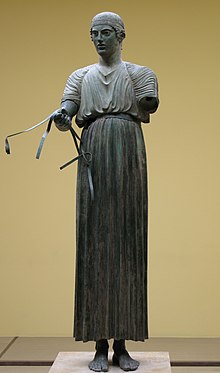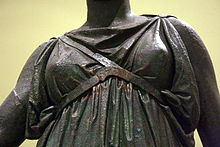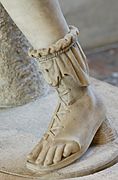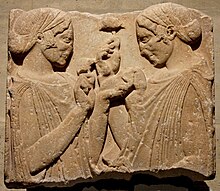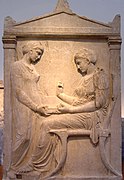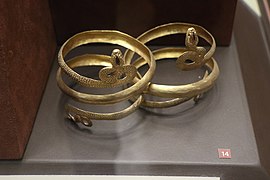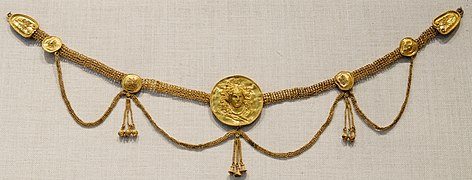Clothing in Ancient Greece
The clothing in Ancient Greece was generally very simple in character, often consisting of a single rectangle of cloth, not sewn, but wrapped around the body, with almost identical styles in both clothing masculine as well as feminine. The only garment that was exclusive to women was the peplos. This fashion remained practically unchanged over the years, only the fabrics and materials used and the way in which they were worn changed, according to which it was possible to distinguish the different social classes of the wearer. The clothing was mainly based on necessity, function, materials and protection rather than identity. Therefore, the clothing was quite simple, draped, loose, and free-flowing.
All clothing in ancient Greece was made of natural fibers. Linen was the most common fabric due to the hot weather that lasted most of the year. On the rare occasions when the weather was colder, the ancient Greeks wore wool. Common clothing of the time was white, or neutral in colour, sometimes incorporating decorative borders. There is evidence of elaborate design and bright colours, but these were less common among lower-class citizens. However, noble citizens they used bright colors to express their wealth, since dyed clothing was more expensive.
The Greeks had a great appreciation for the human body, and they showed it in their own way. The cloth was expertly wrapped around the body, and the cloth could be slightly see-through. Men had no problem with nudity, while women could only be naked in public baths.
The clothing of the ancient Greeks has quite often influenced modern fashion, especially in today's globalized world. Big modern brands like Zuhair Murad, Dolce and Gabbana, Gucci, Chanel and Versace have taken elements of Greek clothing for their ready-to-wear and haute couture collections. Most notably, Gianni Versace used Ancient Greek inspiration and motifs in his collection. In fact, their entire brand is based on Greek culture. The Versace logo is the head of the mythological Medusa surrounded by the traditional meander pattern that symbolizes eternity. He also made a collection inspired by Greek temples and ruins. In addition, the famous Chanel fashion house dedicated its entire Resort 2018 collection to ancient Greece with references to ancient clothing, gods and goddesses, architecture and culture. In addition to using Greek silhouettes and clothing styles, Chanel staged the show in ancient Greek ruins, providing a refined theatrical experience for her audience. Chanel's creative director, Karl Lagerfeld, is quoted by Vogue editor Luke Leitch: "The criteria of beauty in ancient and classical Greece are still valid. There have never been more beautiful representations of women. Or a prettier column. The Renaissance, in fact, was based on antiquity."
Men and women of ancient Greece generally wore two pieces of clothing that covered the body: an undergarment (chiton or peplos) and an outer garment (himation or chlamys).
- The chin, was a robe, usually without sleeves that reached to the elbow and blinded to the waist:
- The hyathion consisted of a kind of rectangular mantle that lay on the left shoulder and was collected on the opposite side, leaving the arm of this part normally free in its movements; and when it was going to travel or to war, the heath was changed by the chlamide, rectangular layer on three of its sides and something circular on the part that surrounded the neck, shorter than the blanket and that was abrochuted.
The tunic or chiton suffered many variations, one of them being the exomis, typical of workers or slaves that exposed the right shoulder with the entire arm. Likewise, the long tunic, typical of noblemen, philosophers and women, and the diplois or double chiton, made up of a very long tunic that redoubled towards the waist.
These pieces were made of linen, wool or byso and later of silk, with few cuts and seams, and were fastened with brooches or fibulas, and a belt or sash. stripes and other embroideries, always with sobriety and good taste, giving preference to the colors white and green.
In general, the garments could be exchanged between men and women. Although no garments from this period have survived, there are descriptions by contemporary witnesses and in artistic representations. Usually, they used to be made at home, and rectangular fabrics, made of linen or wool, were cut in various lengths.
Type of garments
The two main kinds of garments were the endimata (ὲνδυματα), which was worn over a “shirt”, and the epiblemata (ὲπιβλῄματα), similar to a cloak or cloak, loosely thrown over the naked body or over the endimata.. Subsequent changes applied only to the fashion in the use of these and to their material and ornamental qualities.
Endymata and epiblamata
Literally it means the “clothing that is worn underneath”, that is, directly on the body. The chiton was an endimata, which could be worn under the epiblemata. Other garments such as the peplum could be worn alone.
The epiblemata and the endimata differ mainly in their structure: while the endimata are generally ready-made garments that are hung from the shoulders, epiblemata are mere pieces of cloth wrapped around the body (although they can be fastened with clothespins). Being simple pieces of cloth, it is not clear how the different types of epiblemata were distinguished; it may have been the quality of the fabric or the way the garment was covered. As with endimata, epiblemata changed over time and based on the gender of the user. The most distinctive feature of the epiblemata is that, being draped garments, they offered a greater degree of variation than pre-made garments. Also, as the outermost layer of the dress, the epiblemata had greater potential for personal communication and display.
Spargana
Although the representations of babies are usually naked, showing their sex, in Athens and in other polis, except Sparta, infants were wrapped in a garment called spárgana (σπάργανα), a kind of girdles. According to Plato, children were wrapped in swaddling clothes to help their limbs develop properly. It has been suggested that sparganum would also serve as swaddling clothes. In Euripides' Ion, Creusa recognizes her son Ion, now an adult, whom she had abandoned years before because of the fabrics she had made for him and put in her newborn layette, like a cloth with a Gorgon with her snakes embroidered in the center. It is possible that the spargana were part of the bride's trousseau, which included various types of fabrics that represented the work of several years.
Chiton
The chiton (Ancient Greek: χιτών, romanized: chitōn) was the article of clothing commonly worn in ancient Greece, a light cloth tunic closed by a seam. It differed from the peplos in that it was closed at the shoulders by a fibula or brooch.
It was a simple tunic garment of lighter linen and usually pleated that was worn by both sexes and by all ages. It consisted of a wide, rectangular cylinder of cloth secured across the shoulders and upper arms by a series of clasps. Chitons typically fell to the wearer's ankles, but shorter chitons were sometimes worn during vigorous activities of athletes, warriors or slaves.
Often the excess fabric was placed over a sash or belt called a zone (ζώνη), which was fastened around the waist[3] To distribute the volume a belt was sometimes worn, or a cord was worn around the neck, under the armpits, crossed in the back, and tied in the front.
The Dorians and Ionians, two of the ancient Greek populations, saw it differently. two types of chitons -Doric and Ionic-, named for their similarities with Doric and Ionic columns. The Doric chiton was shorter, simpler, and sleeveless, since the technology for sleeves had not really been created yet. It consisted of a single rectangle of woolen or linen cloth. As in the caryatid on the right, the Doric chiton has a fold at the top, or apoptigma. It could be simply pulled over the body or worn with a partial overlap on the shoulders, this being the most common arrangement for women. It could be closed with side seams, fibulae, or snaps to form a drape.
The Ionic chiton required a much longer piece of linen or woolen fabric, and was held together by stitching or pinned all the way around the body. At the waist, the excess fabric was stopped by the zoster (ζωστήρ), a belt that determined a drape that could also originate two large flared sleeves; later another thin and elegant ribbon was placed, in full view, under the breast. It could be supported on both shoulders or only on the left, thus leaving the right free, a preferred solution for those who carried out manual tasks. Unlike the Doric, it did not have an apoptigma, and was a rectangle of cloth long enough that when folded in half it would complete its full span. Before shaped sleeve patterns existed, the Greeks fastened them with fibulae at the end of both arms to join the edges of the top front and back of the fabric. The Ionic chiton also had a belt at the waist. The Doric was generally made of linen and the Ionic of wool.
The chiton with wrist-length sleeves was devised by the Minor-Asian Greeks.
- Double chin
The double chiton was a development of the chiton. It was a very long, intertwined, rectangular piece of cloth, open on one side. It was about one and a half times the length of the body. The protruding part of the fabric was folded around the chest and back, from the neck down. The top edge was placed around the neck and the two open corners were buttoned together over one shoulder. Over the other shoulder, the top edge of the chiton was also fastened with a clasp, and the arm was inserted through the left opening between this clasp and the corresponding corner of cloth.
- Half-open chin
In the same way, the half-open chiton was donned, the open side of which was sewn from the belt to the lower hem.
- Double closed
This variety of chiton reached to the feet. It was a piece of cloth much longer than the human body and was closed on both sides. You had to get inside as if it were done in a cylinder. The protruding part of the fabric was turned outwards and the folded edge was carried up to the shoulders, crossing (first to the right side and then to the left) the front and back parts and fastened by means of brooches. The arms were drawn out through these two openings. Around the hips the chiton was fastened with a belt, with which the lowest part of the cloth that dragged on the floor was pulled, enough to allow the toes to be exposed. The chiton was placed in folds on the belt, shorter or longer. Most likely the protruding part of the chiton, which could also be an independent garment, was called diplois (διπλοἷς) or diploïdion (διπλοἷδιον). The main changes in fashion affected the placement of the diploïdion, which either reached below the chest or extended to the hips. The front and back parts could be fastened together across the shoulders, or the edges could be crossed in several places by fibulae or brooches; thus the bare arm was visible at intervals, and therefore the sleeveless chiton gave the impression of having sleeves. Where the diploïdion separated from the chiton it formed a kind of cloak which, however, in its shape resembled the diploïdion itself. This layer was probably called ampechonion (ὰμπεχονιον). Its shape was considerably modified with fashion, sometimes taking the form of a kind of close-fitting jacket; in others (when the sides were left open) that of a kind of shawl, the ends of which were the same length as the chiton itself. in the second case the ampechonion was at least three times as long as it was wide.
- Quitonisco
Greek men sometimes used a short version called chitonisks (χιτωνίσκος). On ceramic vases, men were represented with chitonisks when engaged in agricultural activities and hunting, or they wore them under armor in battles. A normal chiton in a long version could also be worn on top of the chitonisks.
Peplos
The predecessor of the himation, the peplos (πέπλος) was a square piece of cloth originally worn by women over the chiton. The upper third of the cloth was folded over and pinned to both shoulders, leaving the fabric open down one side. This upper part of the peplos, which is folded down to the waist, forms an apoptigma. Peplos were sometimes worn alone as an alternative form of chiton. As with the chiton, a sash or belt was often worn to hold the pleats at the waist.
Himation
The himation (ἱμάτιον) was a simple outer garment worn over the peplos or chiton. It consisted of a heavy rectangular cloth. To place it, the back and shoulders were first covered, letting the two points that formed the two lower corners of the rectangle of cloth fall forward. The outstretched arm allowed the folds to pass under the left arm and was fastened, already bent, on the right shoulder, from where the pleats fell in a point down the back. The himation fold could also be gathered up to the chin or made to pass over the head like a hood. The Athenian orators of the IV century a. C. spoke in the gallery with the folds passed under the right armpit and then up the fabric across the chest like a scarf to the left shoulder, which allowed the right arm to be completely free.
The himation could be thrown over the head to cover the wearer when overcome by emotion or shame.
In cold climates, larger himations were used.
Clamis
The chlamys (χλαμΰς) was a seamless square or rectangular piece thrown over the left shoulder. The open ends crossed over the right shoulder and were held in place with a fibula. The hanging corners were kept straight, as in the himation, by means of weights sewn to them. Being very open and floating, it did not cover the body like the himation and did not avoid wearing a tunic.
Its use was widespread among travelers, soldiers, and youngsters. The soldiers, especially the cavalry, wore a short cloak, made of stiffer, thicker cloth, fastened over the shoulder with a buckle.
Trib
The Tribón (τρίβων) or Tribónion (τρίβωνιον) was a variant of the himation, simpler and more unadorned. Also rectangular in shape, it was placed on one corner over the left shoulder from the front and held to the body by the left arm. At the back, the garment was pulled to the right side until it completely covered the upper part of the right shoulder, or at least up to the armpit, in which case the right shoulder was exposed. Finally it was thrown over the left shoulder again so that the ends fell on the back.
Humble people wore the tribón out of economy, or cynical philosophers out of contempt for comforts. Everyday coat, often well worn, made of rough sackcloth-like wool and reddish-brown in color, many Greeks like Socrates had no other clothing. An Athenian edict prohibited appearing dressed in this garment in public places, especially in the Greek theater, because fleas and bedbugs were confused with the color of the trifle that carried them.
Underwear
Bras
Minoan women on the island of Crete wore garments that partially supported and also revealed their breasts; the best known example of this style is the Serpent Goddess. Her clothing somewhat resembled a modern lacy corset or corselet. The bra was worn outside of clothing and supported and exposed the breasts, pushing them up and making them more visible. The next civilization, the Mycenaean, emphasized the breast, which had special cultural and religious significance, associating the mature figure with fertility and procreation.
Women often wore a strophion (στρόφιον), the brassiere of classical times, under their garments and around the midsection of their bodies. The strofion was a wide woolen or linen band that wrapped around the breasts and tied between the shoulder blades.. Women wore an apodesmos (Greek: ἀπόδεσμος), later stethodésmos (στηθοδέσμος), mastódesmos (μαστόδεσμος) and mastódeton (μαστόδετον), terms meaning the same, "breast band", a woolen or linen band wrapped around the breasts and tied or fastened behind the back.
Another term was kestós (Greek: κεστός, Latin: cestus), used specifically for Aphrodite's enchanted girdle in the Iliad, whose power was to make her irresistible. for men to every woman who used it. In view of her association with the goddess of love, this type of garment probably had an erotic connotation due to its effect of accentuating the chest.
Buttons and zippers
Because clothing was rarely cut or sewn, zippers and buttons were often used to hold garments in place. Small buttons, pins and brooches were used.
Large pins, called perónai (περόναι) or fibulae, were worn on the shoulders, facing downwards, to hold the chiton or peplos in place[1].
Men and women sometimes wore triangular loincloths, called perizomas, as undergarments. The perizoma, Latin: perizonium, and Greek: περίζωμα («around the waist»), was a cloth that served as underpants during Antiquity. Its oldest records date back to the Minoan civilization on the island of Crete.
Belts, girdles, or cummerbunds were also worn at the waist, sometimes replacing brassieres or buttons. They were buttoned over a simple garment or tunic-like undergarment, just below the breasts or over the breasts. When the apodesmos was worn under the breasts, it accentuated them.
Shoes
Women and men often wore sandals, slippers, soft shoes, or boots. At home they often went barefoot.
In footwear, the difficulty lies in matching the numerous names that appear in the texts with the representations of the monuments. Many of the proposed identifications remain uncertain. Often the footwear was made to measure. In this case, the shoemaker cut directly into the sole around his customer's foot.
The main and most widespread model of Greek footwear was the pédilon (πέδιλον), a primitive form of sandal, consisting of a leather insole, cut in the shape of the foot, which was held with a series of bands that reached the instep. This footwear evolved into the most elaborate and resistant sandals, which in the female variants could even be colored. The sandals were mere soles, made of cork, wood or leather, held up by straps tied around the ankle and first toe. foot, which exposed the top of the foot.
The evolution of the art of shoemaking led to the creation of the krēpís (κρηπίς), typically masculine open shoes, from which the endromis (ἐνδρομίς) was derived, whose laces they went up to the knee, and that were typical of the military uniform. The embás (εμβάς), was a boot probably of Babylonian or Thracian origin, it was one of the first models of closed shoes, both male and female, produced in numerous modalities (low or high) and in different colors. It was tied in the front and ended at the top with a kind of turn, buttoned. The endromís was similar, but lacked a return. The coturno, of Lydian origin, which Aeschylus is said to have transformed to adapt it to the theater, was a shoe with a high sole, which fitted less than the previous ones, since it could be worn either on the right or left foot, and which It was used especially for the actors in the tragedy, giving it then great height with a very thick wooden sole.
Women's shoes had much more varied and elegant shapes. The names of some of them, such as the Persians or Laconians, indicate their origin, but their description becomes difficult. To appear taller, women used a kind of heel that was placed between the foot and the shoe.
The typical female shoe for particularly formal occasions, such as ceremonies and weddings, was the diábathron (διάβαθρον), adorned with metal applications. The very expensive baucis (βαυκίς) was instead the typical shoe of the ether, whose characteristic was to significantly increase the height of the wearer, the same characteristic that distinguished the coturno (κόθορνος), the high boots worn by the actors tragic.
The leather of women's footwear was dyed in different colors: black, red, white or yellow. The artisans of various cities made famous models such as those of Argos, Sición and Rhodes. to the range of the mountain towns.
Hats and headdresses
Unlike the fashion in modern hats, hats in ancient Greece had a purely practical function, and were mainly used to protect the wearer from the sun's rays, during work in the fields, or to protect themselves. from the cold, like alopecis (ἀλωπεκίς), made of fox fur. The pilos (πῖλoς) was instead a felt cap intended for the poorer classes, and used mainly for the "healing" of children and the elderly. It was a high crown hat, more or less conical and pointed in shape, which could be provided with a visor to protect from the sun, and could also have various decorations. It was usually made of strong felt and quite stiff, so it wouldn't crush easily. It could also be made of leather and even metal. The characteristics of this harness could vary depending on the place and region. Herodotus calls the high tiara of the Persians pilos.
The term pilidion (πιλίδιον), diminutive of pilos, designated a different hat. Simple felt or wool cap, it was a kind of nightcap that doctors sometimes recommended to patients to keep their heads warm. This same cap, devoid of a visor and ornaments, was worn by slaves in the fields and by the townspeople: peasants, shepherds, artisans, sailors and boatmen. It is the headdress of the god Hephaestus, who was the patron of the workers.
The cuné (κυνέη) was a fur cap (literally: "dog fur") whose shape and use were very similar to those of the pilidion.
The traveler's hat, like that of the god Hermes, was the petasus, a wide felt or straw hat with very wide brims and a low crown, with a bridle that allowed it to be pushed back and carried on the back.
The kausίa was a long, flat felt hat of Macedonian origin, while the Phrygian cap was a conical hat with the tip bent forward, of Anatolian origin. A hat intended for women was the krήdemnon, similar in shape to the male petasus. Finally, the pole (πόλος) was a cylindrical or quadrangular hat, typical in representations of female deities, and which was actually used in ceremonies.
The Greeks used to go bareheaded down the street but when it was necessary to take shelter from the elements, they wore the pileus, a semi-ovoid leather cap or the miter as an oriental turban or the petasus, which was a felt hat and with at.
The women's headdresses were simple in taste. As a rule they did not wear hats, at least in Athens, because their presence in the streets was considered inappropriate, and they only appeared on exceptional occasions: festivities, funerals, etc. On trips they carried a light, broad-edged petasus to protect themselves from the sun.
Greek women covered their heads with a veil called calyptra, when they did not wear the cloak to cover it or the fold of their tunic as a hood. In the Archaic Period they wore veils that covered them. it covered the face up to the eyes and fell over the neck and back in great folds to cover, if necessary, the entire upper part of the body.
Nets and snoods, and later headscarves, developed from the simple ribbon, collectively called kekryfaloi.
The cecriphalon itself was a kind of shawl or snood or headscarf tied around the hair, and not a true hat. the one at the back, which was tied with a ribbon at the top (sakkos).
The women had a round headdress with wide wings whose center ended in a point, the tolia, which was definitely a variant of the petasus. Terracotta figurines from Tanagra show the distinction with which women knew how to wear the tolia.
Both men and women wore a headband called a tenia for festivals. Another type of headband was called sfendone —for its similarity to slings—, made of cloth or decorated leather, wide in the center and tapering at the ends. It was either placed with the wider side on the front of the head, and the ends, with ribbons tied to them, covered with the hair at the back, or vice versa. In the latter case, the ends were tied on the forehead with an elaborate bow. They also used a diadem, which consisted of a strip of cloth or leather, often decorated in the part that rested on the forehead, with a metal sheet in the shape of a front, called stefané. This diadem appears in representations of goddesses, in the shape of a wide metal circle, intended not only to hold the hair up, but to adorn it.
It was not uncommon for women to comb their front hair over the temples and ears, and tie it, along with the back hair, in a knot.
Fabrics
The Greeks had linen, goat hair, which after weaving it into bastes or saccos —a coarse fabric—, and wool. The existence of cotton (which Herodotus calls « vegetable wool"), and silk, they knew it vaguely.
The fabric was not cut to fit the body measurements and then sewn, but the rectangular piece that came out of the loom, after being treated by the dyer and the fuller, was freely wrapped around the body in many different ways and was fastened with belts, brooches, brooches and some stitching.
Firstly, flax, raw or processed, was imported by the Greeks from Europe, Asia Minor and the East, where it was cultivated. Later the plant acclimatized in Thrace, Macedonia, Achaia and other regions, and on the islands of Cyprus, Amorgos and Crete. After drying in the sun, the flax stalks were cooled in lukewarm water. Later they were dried again and with a mallet they were crushed on stones, to separate the bark from the internal fibers, which were then spun and woven.
The preparation of the wool, its thread and weaving were women's tasks done in the oikos, but there were male artisan workshops: those of Mégara made exomis of a highly appreciated quality. The change of season required modification in the thickness of these woolen garments. For women's winter dresses, apart from sheep's wool and linen, byso was used, probably a kind of cotton. Finer than byssus, were the transparent suits called amorgina, made on the island of Amorgos. They were made with fiber of a type of fine linen, similar to muslin and batiste.
With the goatskins they made loincloths, the caunaces of the Persian shepherds, adopted by the Greeks, and mocked by Aristophanes due to their rusticity: "When you bring the goats from Feleo's return, like your father, dressed in a fur coat...». >V a. C., the downy fabric of the winter cloaks of the Athenians.
With skins, priestly or initiation uniforms were made, as were those of the Dionysian rites. Another type of skin from non-domestic animals was worn by the followers of the festival of the Dionysias. It was the nebris, made with speckled fawn skin, which in The Bacchae by Euripides, Dionysus wears on top of the long dress of Pentheus.
From the interior of Asia, silk was imported to Greece, partly raw, partly in ready-made costumes. The latter were called seriká, to distinguish them from those made in Greece, called bubikiná. The island of Kos was the first center of silk production, whose garments rivaled in transparency with the amorgina. These costumes that adhered to the body and allowed the skin to be seen, were imitated by sculptors and painters.
Colors and ornaments
The most common colors in clothing were, of course, the natural white of the fabrics, but also some natural colors such as yellow, turquoise and wine. Red was less common, since the coloring technique used consisted of the use of purple, which made production costs considerably higher. However, red was the color worn by heteras and ballerinas, therefore it was not widespread.
The color white was common in the epiblemata and was preferred among women of modest class. The wealthy class also used the partially colored oriental garments. Brown cloaks and saffron-yellow dyed chitons were not uncommon.
The Spartans entrusted the work of dyeing clothes to periecos, immigrant workers, who dyed the soldiers' clothes scarlet so that blood stains would go unnoticed. The ingredient they used is unknown.
Gowns were often embellished with interwoven patterns or with added piping and embroidery. In addition to the fringe ornaments, other wider and more elaborate ones were made; it is doubtful if they were woven with the suit or sewn. There were those that covered the chitons from the hem to the knee, and over the belt to the neck. Sometimes the entire chiton would be covered in star and dice patterns.
The ceramic vase painters of the IV century a. C., represented Phrygian costumes with gold stripes and sumptuous embroidery of serpentine prints and palmettes, as worn by the Greeks of Magna Graecia.
Men's clothing
Men wore no undergarments under their tunics. The simplest model of tunic was the exomis, which was the garment of slaves, free workers and almost all soldiers. Short in length, cinched at the waist with a belt and attached to the shoulder with a simple knot or a fibula, it could be open or sewn on the left thigh. It left the right half of the torso exposed in a wide way.
The chiton, when short, differed only from the exomis in that it was usually tied to the shoulders with ribbons or brooches. The belt that adjusted it formed a series of hollow folds around the waist called colpos. Frequently it was necessary to put on another belt, the zoster, a leather belt for military use that formed a second colpos, as is visible on a standing knight, in front of his horse in the frieze of the Panatheneas.
They did not take off their tunics to sleep, they did take off their belts, as they used them as a nightgown at night. The children wore short tunics without a belt, like the one worn by young Theseus in the Cup of Euphronius in the Louvre museum.
Adult men and ephebes of the Doric tribes wore a garment called a tribon (in ancient Greek: τρίβων or τρίβωνιον), rectangular and much smaller than the himation, and children up to the age of twelve, only wore the chiton. The philo-laconism present in Athens made this garment common. The Athenian boy's tunic consisted solely of the chiton until the Peloponnesian War (431 BC). Upon reaching the Ephebeian age, they wore a chlamys, a cloak introduced into Attica from Thessaly or Macedonia.
Women's clothing
Women's clothing, in principle, did not differ from men's. The particular arrangements and coquettish details gave it a very different look, despite being basically a rectangular piece of wool or linen, just as it came from the loom, and which freely adapted to the body thanks to brooches or some thread stitches..
The most elementary female dress was that of young Spartans. It is about the open and short peplos that served both as a tunic and as a cloak. It was a rather narrow woolen shawl, tied at the shoulders by brooches; there was no belt or seams. Only one side of the body was covered and the other side was exposed at the slightest movement. Plutarch reports that they wore "that kind of tunic whose sides, since they were not sewn at the bottom, partly opened and left their thighs exposed when they walked, and from this comes the name fainoméridess" it gave them (the ones that show the thighs)". to collect, pinned with fibulae, all that was left over vertically. The woolen garment, which was still open on one side, was folded over on itself at the top. A more or less long outer garment was formed from a single piece on the inside, without any seams. In the same way, if the width exceeded that of the chest, the free edges fell, all over the side opening in cascades of pleats that gave a special consistency to the dress." If the pleat was long enough, the back part could be passed above the head to form a kind of veil or hood. Some women depicted on funerary stelae are dressed in this manner. When the fold remained in the normal posture it could be divided into two parts at the waist by means of a belt. This was the dress of Athena Partenos of Phidias, according to surviving replicas. The belt not only kept the folds tight, and prevented the right leg from being exposed when walking, but also cleared the torso and contributed to offering a more noble and austere silhouette. If the fabric did not fit over the chest, it could form the bulge of hollow folds (colpos). an arm opening. The fit of the open peplum was necessarily asymmetrical; that of the closed peplos, which generally had a cylindrical shape, was symmetrical. The closed peplum could also have folds and a belt. This is the dress of the ergastinas in the frieze of the Parthenon, in the Louvre museum.
The Greeks always used the wool of their sheep for clothing, while linen was first imported from Ionia, before being cultivated in various regions of Greece. For a long time, linen was considered a luxury dress and its use spread slowly, first among the wealthy class. The old wool peplum, although the most presumptuous women stopped wearing it, continued to be the dress of the peasant women and of the majority of the women of the town, in addition to the slaves.
Athenian women wore both the Dorian peplos and the finely pleated linen chiton called the Ionian.
The short chiton of Dorian women had a short skirt and a slit on both sides at the top. It was fastened on the men by brooches. By pulling on the belt it could be shortened to the knees. The long chiton reached to the feet, and was pulled very low at the belt.
Over the chiton, a dress that warmed the body less than the peplos, women wore various kinds of cloaks in winter, such as a simple shawl tied like a scarf over one shoulder, or a round shawl (encyclo), or a peplos that served as an outer garment, or also a long puffy himation, similar to that of men, but whose cloth generally fell more elegantly in front, and not in back. Sometimes this cloak, folded several times lengthwise, was supported on the arms, from behind, and thus, on painted vases, it has the appearance of a long shawl.
The caryatids of the Erechtheion wear long chitons. The kolpos (folds) and diplois (folds) are carved in symmetrical folds. Despite the calamae posture required by the architectural character of these canephoras, the sculptors devised the sensation of movement by slightly tilting the left leg, and consequently the folds of the chiton are not straight.
The placement of the himation worn by women was not subject to a strict rule as in the case of men. The one worn by young women carrying hydrias in the Parthenon frieze can be considered the common type. The common type of peplos is also represented in a scene on the east frieze of the Parthenon. To preserve the pleats and prevent the dress from slipping, tiny weights were often sewn into the corners.
In the IV century B.C. The elegant young women depicted in the terracotta figurines from Tanagra are cloaked, in artfully placed, flowing cloaks that almost completely cover their robes, and a cloth from this cloak could be worn over their heads as a hood.
Although poor Athenians continued to weave their own garments themselves, artisans in some cities had become quite famous in one or another costume specialty. The island of Amorgos exported rich linen tunics, which fetched a high price, while Sicilian linen could be made at an affordable price. Long Corinthian dresses (calasireis) were also highly prized. Chios, Miletus and Cyprus sold their embroidered dresses in distant places. Pelene also made highly appreciated cloaks and byssos, a fine quality linen, which was spun in Patras, was highly sought after by elegant upper-class women.
Jewelry
Athenians in the time of Aristophanes wore metal ankle rings, though jewelry was an exception.
In classical times, in everyday life, jewelry was practically reserved for women, except for the rings with a chaton that men used to engrave their seal (sfragís) of clay or wax on letters or documents.
Ornamentation in the form of jewelry, elaborate hairstyles, and make-up was common among women. They often wore necklaces, bracelets, and earrings around their legs. There is evidence that the Greeks had rings, crowns, and diadems., bracelets, bangles, pins, pendants, necklaces and earrings. Popular earring designs included: flying gods and goddesses, such as Eros, Nike, and Ganymede. Patterns like the meander symbolizing eternity were also commonly engraved on jewelry. Gold and silver were the most common metals for jewelry, however jewelry from this era could also have pearls, gems, and semi-precious stones used as decoration. Jewelry was commonly passed down from generation to generation or made as an offering to the gods. The heavy pendant necklaces of the Mycenaean and Archaic times in Periclean times were hardly worn and were replaced by lighter chains from which amulets were sometimes hung. Bracelets were worn on the wrist, but also between the elbow and the shoulder, when the upper part of the arm was bare, outside the peplos. They consisted of spirals or simple rivers of gold or silver that could be closed with a figurine; often this jewel was in the shape of a snake that coils on itself.
The custom of piercing the earlobe to put on jewelry is common to all ages. The Greeks of the time of Pericles wore small ornate precious metal washers in their ears. Sometimes, animal figurines were hung, as an amulet. The fashion for ankle or calf rings was widespread, presumably with religious or magical (apotropaic) significance.
The women kept the jewelry in a chest that a slave presented to them whenever they wanted to bejeweled. It is a scene that has been frequently represented on Greek ceramics and also on funerary reliefs such as the Hegeso stela.
Plugins
The fan (ripis) was a simple screen with a handle, which was usually circular or palm-shaped, whose stem served as a handle, or heart-shaped: made with thin sheets of wood. The colors were green, blue, white and gold.
Umbrellas (skiadion) were used by wealthy women to protect the fairness of their complexions and closely resemble modern parasols. They were made of rounded cloth stretched over a determined number of rods converging in a ring that slides freely along a stick that serves as a handle. Fringing was sometimes attached to the end of the ribs all the way around the parasol. It was almost always carried by a slave who stood behind the woman whom he protected from the sun. In the processions of the Panatheneas and Scirophorias, a white parasol was carried before the priest of Poseidon and the priestess of Athena.
Contenido relacionado
898
524
70




